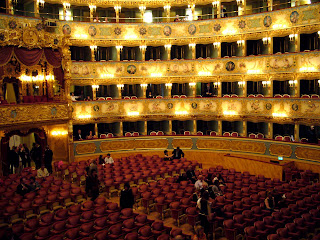The interior of La Fenice, September 26, 2010, from our balcony seats.

La Fenice, September 26, 2010


The patio at the Bauer Palladio. The garden at the Bauer Palladio.
Our five week trip was delayed by two days so that Joyce could recover from an intestinal bug but it worked out for the best because the flying weather was near perfect, we had a strong tail wind -- 128 mph! -- so we arrived nearly a half hour early, and the weather in Venice was spectacular. The trip from the Marco Polo airport to our hotel, Bauer Palladio, was less than 30 minutes. The Bauer Palladio is a converted Palladio building on Giudecca, a short water taxi ride from San Marco, and directly across from its much more expensive sister hotel, Bauer Palazzo. It is unpretentious from the outside but the interior is relatively new and well designed. We were upgraded to a suite, and it is well appointed with a grand and practically new marble/granite bathroom, complete with Jacuzzi. The outdoor garden is a visual delight, and has a sweet fragrance from the many rose bushes.
After a latte and some dolci, we prepared for our trip to La Fenice. The vaporetto was much more comfortable than the vaporetto of ten years ago, with real seats, and the trip from the landing on Giudecca very near the Bauer was under ten minutes. The walk from the vaporetto dock on San Marco was circuitous because of flooding in Piazza San Marco from a recent heavy rainstorm, but we found La Fenice without much difficulty. A prosecco and a cappucino at our favorite restaurant directly across from La Fenice helped restore our somewhat flagging spirits - - sleep on an airplane is fitful at best. Part of the reason for the timing of the trip to Venice was to see La Traviata at La Fenice, where it premiered in 1853, and the presentation could only be charitably described as Eurotrash. Violetta was transformed from a sophisticated courtesan and favorite of petty nobility to a common whore: the opening scene is in Violetta's bedroom and a succession of johns parades in, each one crassly handing her a fistful of U.S. dollars (more about the producer's use of American themes later). This scene is followed by Liabiamo, with a near-orgy of demimonde characters in outlandish costumes. In fairness the singing was quite good, and Violetta was well performed by Ekaterina Sadovnikova. One of the highlights for us was the conductor, Stefano Rabaglia, who not only had committed the music to memory, but who also was the prompter as he mouthed the entire libretto while conducting!
The use of American dollars pervaded the performance: the country scene in the second act takes place in a forest whose floor is littered with a deep carpet of U.S. dollar bills, which continue to flutter down during the remainder of the act, including one stray bill that landed in the orchestra pit on a violinist. But the highlight (or lowlight) was the dance scene after Violetta abandons Alfredo. Instead of the Met's bull fighting pantomime, this version used a dozen scantily clad men and women in the producer's vision of American cowboy costumes, who mimicked lewd acts as part of the choreography. Very distracting and off-putting: Violetta is no longer the pitiful and tragic fallen woman but just another denizen of a world that we know is there but would rather not explore, at least not with Verdi's exquisite music which seems so out of place. Sadovnikova is blonde and was a credible prostitute; however, Patrizi Ciofi alternates with Sadovnikova and it is difficult to imagine her performing as well in this characterization.
We had less than optimal seats in the balcony with a partial view, but because La Fenice is so small, we had terrific closeups of the singers, the stage and the orchestra.
We returned to the restaurant across from La Fenice and had a first class risotto, some Chianti, and a spectacular ricotta cheesecake. We somehow made it back to the hotel on the private launch operated by the two Bauer hotels, and collapsed into bed for a much needed night's sleep!
 The Venetians want everyone to know where the giudei live(d)
The Venetians want everyone to know where the giudei live(d) Casa Israelitica di Riposo in the Venice ghetto
Casa Israelitica di Riposo in the Venice ghetto The campo of the Venice ghetto
The campo of the Venice ghetto Gam Gam restaurant in the Venice ghetto - the images on the wall are Torah excerpts
Gam Gam restaurant in the Venice ghetto - the images on the wall are Torah excerpts  I Musici Venezia recital at Scuola Grande di San Teodoro
I Musici Venezia recital at Scuola Grande di San Teodoro





